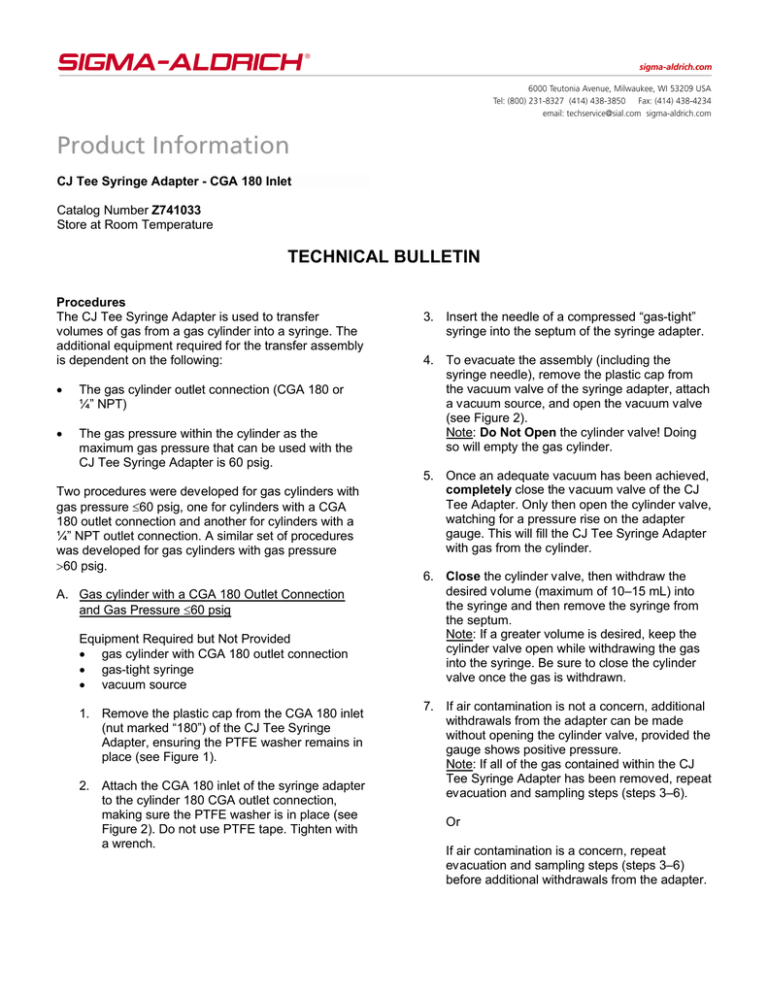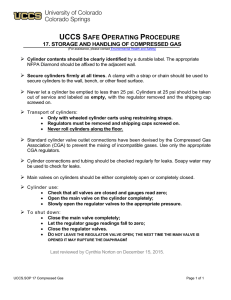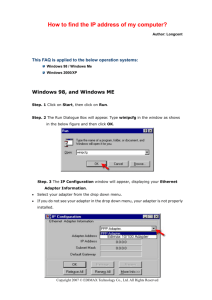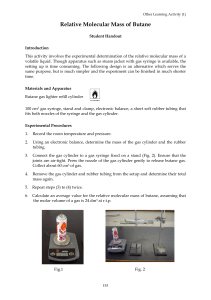
CJ Tee Syringe Adapter - CGA 180 Inlet
Catalog Number Z741033
Store at Room Temperature
TECHNICAL BULLETIN
Procedures
The CJ Tee Syringe Adapter is used to transfer
volumes of gas from a gas cylinder into a syringe. The
additional equipment required for the transfer assembly
is dependent on the following:
•
The gas cylinder outlet connection (CGA 180 or
¼” NPT)
•
The gas pressure within the cylinder as the
maximum gas pressure that can be used with the
CJ Tee Syringe Adapter is 60 psig.
Two procedures were developed for gas cylinders with
gas pressure ≤60 psig, one for cylinders with a CGA
180 outlet connection and another for cylinders with a
¼” NPT outlet connection. A similar set of procedures
was developed for gas cylinders with gas pressure
>60 psig.
A. Gas cylinder with a CGA 180 Outlet Connection
and Gas Pressure ≤60 psig
Equipment Required but Not Provided
• gas cylinder with CGA 180 outlet connection
• gas-tight syringe
• vacuum source
1. Remove the plastic cap from the CGA 180 inlet
(nut marked “180”) of the CJ Tee Syringe
Adapter, ensuring the PTFE washer remains in
place (see Figure 1).
2. Attach the CGA 180 inlet of the syringe adapter
to the cylinder 180 CGA outlet connection,
making sure the PTFE washer is in place (see
Figure 2). Do not use PTFE tape. Tighten with
a wrench.
3. Insert the needle of a compressed “gas-tight”
syringe into the septum of the syringe adapter.
4. To evacuate the assembly (including the
syringe needle), remove the plastic cap from
the vacuum valve of the syringe adapter, attach
a vacuum source, and open the vacuum valve
(see Figure 2).
Note: Do Not Open the cylinder valve! Doing
so will empty the gas cylinder.
5. Once an adequate vacuum has been achieved,
completely close the vacuum valve of the CJ
Tee Adapter. Only then open the cylinder valve,
watching for a pressure rise on the adapter
gauge. This will fill the CJ Tee Syringe Adapter
with gas from the cylinder.
6. Close the cylinder valve, then withdraw the
desired volume (maximum of 10–15 mL) into
the syringe and then remove the syringe from
the septum.
Note: If a greater volume is desired, keep the
cylinder valve open while withdrawing the gas
into the syringe. Be sure to close the cylinder
valve once the gas is withdrawn.
7. If air contamination is not a concern, additional
withdrawals from the adapter can be made
without opening the cylinder valve, provided the
gauge shows positive pressure.
Note: If all of the gas contained within the CJ
Tee Syringe Adapter has been removed, repeat
evacuation and sampling steps (steps 3–6).
Or
If air contamination is a concern, repeat
evacuation and sampling steps (steps 3–6)
before additional withdrawals from the adapter.
2
Figure 1.
CJ Tee Syringe Adapter - CGA 180 Inlet
CGA 180 inlet
Figure 2.
Assembly of Syringe Adapter and Gas Cylinder
Gauge
Cylinder
valve
Syringe
Outlet
connection
Septum
Vacuum valve
3
B. Gas cylinder with a ¼” NPT Outlet Connection and
Gas Pressure ≤60 psig
For cylinders with a ¼” NPT outlet connection, an
adapter must be added to the transfer assembly
used in Procedure A.
Equipment Required but Not Provided
• gas cylinder with a ¼” NPT outlet connection
• CGA to ¼” adapter (Catalog Number Z147303)
• gas-tight syringe
• vacuum source
• PTFE tape
1. Wrap PTFE tape 3–5 times around the ¼” NPT
threads of the cylinder outlet connection and
attach the CGA to ¼” adapter (Catalog Number
Z147303). This is a thread seal and must be
tightened with wrenches to engage the threads
for a leak-proof seal. Make sure to use
2 wrenches to prevent removal of the cylinder
outlet connection - one on the cylinder outlet
connection body and the other on the adapter
(see Figure 3).
2. Remove the plastic cap from the CGA 180 inlet
(nut marked “180”) of the CJ Tee Syringe
Adapter, ensuring the PTFE washer remains in
place, and connect this to the other end of the
CGA to ¼” adapter. Do not use PTFE tape.
Tighten with a wrench (see Figure 4).
3. Insert the needle of a compressed “gas-tight”
syringe into the septum of the syringe adapter
(see Figure 5).
4. To evacuate the assembly (including the
syringe needle), remove the plastic cap from
the vacuum valve of the syringe adapter, attach
a vacuum source, and open the vacuum valve
(see Figure 5).
Note: Do Not Open the cylinder valve! Doing
so will empty the gas cylinder.
5. Once an adequate vacuum has been achieved,
completely close the vacuum valve of the CJ
Tee Adapter. Only then open the cylinder valve,
watching for a pressure rise on the adapter
gauge. This will fill the CJ Tee Syringe Adapter
with gas from the cylinder.
6. Close the cylinder valve, then withdraw the
desired volume (maximum of 10–15 mL) into
the syringe and then remove the syringe from
the septum.
Note: If a greater volume is desired, keep the
cylinder valve open while withdrawing the gas
into the syringe. Be sure to close the cylinder
valve once the gas is withdrawn.
7. If air contamination is not a concern, additional
withdrawals from the adapter can be made
without opening the cylinder valve, provided the
gauge shows positive pressure.
Note: If all of the gas contained within the CJ
Tee Syringe Adapter has been removed, repeat
evacuation and sampling steps (steps 3–6).
Or
If air contamination is a concern, repeat
evacuation and sampling steps (steps 3–6)
before additional withdrawals from the adapter.
4
Figure 3.
CGA to ¼” Adapter Attached to cylinder outlet connection
Cylinder
outlet
CGA to ¼”
adapter
Figure 4.
CJ Tee Syringe Adapter Attached to CGA to ¼” Adapter
CGA 180
inlet
CGA to ¼”
adapter
Figure 5.
Assembly of Syringe Adapter, CGA to ¼” Adapter, and Gas Cylinder
Cylinder valve
Syringe
Septum
Vacuum valve
5
C. Gas cylinder with a CGA 180 Outlet Connection
and Gas Pressure >60 psig
For gas cylinders with gas pressure >60 psig, an
adapter and gas regulator must be added to the
transfer assembly used in Procedure A.
Note: The maximum gas pressure that can be used
with the CJ Tee Syringe Adapter is 60 psig. The
use of a gas regulator is required to restrict the gas
pressure entering the adapter to ≤60 psig.
Equipment Required but Not Provided
• gas cylinder with a CGA 180 outlet connection
• gas regulator to restrict gas pressure (Catalog
Number Z146714, Z146706, Z148504, or
Z148512)
• CGA to ¼” adapter (Catalog Number Z147303)
• gas-tight syringe
• vacuum source
• PTFE tape
1. Wrap PTFE tape 3–5 times around the ¼” NPT
threads of the gas regulator (flow valve side)
and connect the CGA to ¼” adapter (Catalog
Number Z147303). Use a wrench to tighten
(see Figure 6).
2. Remove the plastic cap from the CGA 180 inlet
(nut marked “180”) of the CJ Tee Syringe
Adapter, ensuring the PTFE washer remains in
place. Connect to the other side of the CGA to
¼” adapter. Do Not use PTFE tape. Tighten
with a wrench (see Figure 7).
3. Connect the right side (regulator valve side) of
the gas regulator to the gas cylinder outlet
connection. Make sure the PTFE gasket is in
place but Do Not use PTFE tape. Tighten with
a wrench (see Figure 8).
4. Insert the needle of a compressed “gas-tight”
syringe into the septum of the syringe adapter
(see Figure 8).
5. To evacuate the assembly (including the
syringe needle), remove the plastic cap from
the vacuum valve of the syringe adapter, attach
a vacuum source, open the vacuum valve and
both regulator valves (the flow valve opens
counterclockwise and the regulator valve opens
clockwise).
Note: Do Not Open the cylinder valve! Doing
so will empty the gas cylinder.
6. Once adequate vacuum has been achieved,
completely close the vacuum valve of the CJ
Tee Adapter, the flow valve (clockwise), and
the regulator valve (counterclockwise).
7. Open the cylinder valve. Slowly open the
regulator valve, adjusting to the desired
pressure, but no greater than 60 psig.
8. Open the flow valve on the regulator. This will
fill the entire assembly with gas from the
cylinder. Watch for a pressure rise on the
gauge of the CJ Syringe Adapter.
9. Close the cylinder valve, then withdraw the
desired volume (maximum of 20 mL) into the
syringe and then remove the syringe from the
septum.
Note: If a greater volume is desired, keep the
cylinder valve open while withdrawing the gas
into the syringe. Be sure to close the cylinder
valve once the gas is withdrawn.
10. If air contamination is not a concern, additional
withdrawals from the adapter can be made
without opening the cylinder valve, provided the
adapter gauge shows positive pressure.
Note: If the maximum volume (20 mL) of gas
has been removed, repeat evacuation and
sampling steps (steps 4–9).
Or
If air contamination is a concern, repeat
evacuation and sampling steps (steps 4–9)
before additional withdrawals from the adapter.
6
Figure 6.
CGA to ¼” Adapter Attached to Gas Regulator
Regulator
valve
CGA to ¼”
adapter
Flow
valve
Figure 7.
Assembly of Syringe Adapter, CGA to ¼” Adapter, and Gas Regulator
CGA to ¼”
adapter
CGA inlet
Figure 8.
Complete Assembly of Syringe Adapter, CGA to ¼” Adapter,
Gas Regulator, and Gas Cylinder
Regulator
valve
Cylinder
valve
Syringe
Gas cylinder
outlet
Septum
Vacuum
valve
7
D. Gas cylinder with a ¼” NPT Outlet Connection and
Gas Pressure >60 psig
For gas cylinders with a ¼” NPT outlet connection
and gas pressure >60 psig, 2 adapters and gas
regulator must be added to the transfer assembly
used in Procedure A.
Note: The maximum gas pressure that can be used
with the CJ Tee Syringe Adapter is 60 psig. The
use of a gas regulator is required to restrict the gas
pressure to ≤60 psig.
5. Insert the needle of a compressed “gas-tight”
syringe into the septum of the syringe adapter
(see Figure 12).
6. To evacuate the assembly (including the
syringe needle), remove the plastic cap from
the vacuum valve of the syringe adapter, attach
a vacuum source, open the vacuum valve and
both regulator valves (the flow valve opens
counterclockwise and the regulator valve opens
clockwise).
Note: Do Not Open the cylinder valve! Doing
so will empty the gas cylinder.
Equipment Required but Not Provided
• gas cylinder with ¼” NPT outlet connection
• gas regulator to restrict gas pressure (Catalog
Number Z146714, Z146706, Z148504, or
Z148512)
• 2 CGA to ¼” adapters (Catalog Number
Z147303)
• gas-tight syringe
• vacuum source
• PTFE tape
7. Once adequate vacuum has been achieved,
completely close the vacuum valve of the CJ
Tee Adapter, the flow valve (clockwise), and
the regulator valve (counterclockwise).
1. Wrap PTFE tape 3–5 times around the ¼” NPT
threads of the gas regulator (flow valve side)
and connect the CGA to ¼” adapter (Catalog
Number Z147303). Use a wrench to tighten
(see Figure 9).
9. Open the flow valve on the regulator. This will
fill the entire assembly with gas from the
cylinder. Watch for a pressure rise on the
gauge of the CJ Syringe Adapter.
2. Remove the plastic cap from the CGA 180 inlet
(nut marked “180”) of the CJ Tee Syringe
Adapter, ensuring the PTFE washer remains in
place. Connect to the other side of the CGA to
¼” adapter. Do Not use PTFE tape. Tighten
with a wrench (see Figure 10).
3. Wrap PTFE tape 3–5 times around the ¼” NPT
threads of the cylinder outlet connection and
attach the second CGA to ¼” adapter (Catalog
Number Z147303). This is a thread seal and
must be tightened with wrenches to engage the
threads for a leak tight seal. Make sure to use
2 wrenches to prevent removal of the cylinder
outlet connection - one on the cylinder outlet
connection body and the other on the adapter
(see Figure 11).
4. Connect the other side of this CGA to ¼”
adapter to the gas regulator. Make sure the
PTFE gasket is in place but Do Not use PTFE
tape. Tighten with a wrench (see Figure 12).
8. Open the cylinder valve. Slowly open the
regulator valve, adjusting to the desired
pressure, but no greater than 60 psig.
11. Close the cylinder valve, then withdraw the
desired volume (maximum of 20 mL) into the
syringe and then remove the syringe from the
septum.
Note: If a greater volume is desired, keep the
cylinder valve open while withdrawing the gas
into the syringe. Be sure to close the cylinder
valve once the gas is withdrawn.
12. If air contamination is not a concern, additional
withdrawals from the adapter can be made
without opening the cylinder valve, provided the
adapter gauge shows positive pressure.
Note: If the maximum volume (20 mL) of gas
has been removed, repeat evacuation and
sampling steps (steps 5–11).
Or
If air contamination is a concern, repeat
evacuation and sampling steps (steps 5–11)
before additional withdrawals from the adapter.
JW,MAM 01/15-1
8
Figure 9.
CGA to ¼” Adapter Attached to Gas Regulator
Regulator
valve
CGA to ¼”
adapter
Flow
valve
Figure 10.
Assembly of Syringe Adapter, CGA to ¼” Adapter, and Gas Regulator
CGA to ¼”
adapter
CGA inlet
9
Figure 11.
CGA to ¼” Adapter Attached to Gas Cylinder
CGA to ¼”
adapter
Cylinder
outlet
Figure 12.
Complete Assembly of Syringe Adapter, CGA to ¼” Adapter, Gas Regulator, CGA to ¼” Adapter, and Gas Cylinder
Regulator
valve
Cylinder
valve
Syringe
Septum
CGA to ¼”
adapter
Vacuum
valve
Flow valve
2015 Sigma-Aldrich Co. LLC. All rights reserved. SIGMA-ALDRICH is a trademark of Sigma-Aldrich Co. LLC, registered in the US and other
countries. Aldrich brand products are sold through Sigma-Aldrich, Inc. Purchaser must determine the suitability of the product(s) for their
particular use. Additional terms and conditions may apply. Please see product information on the Sigma-Aldrich website at
www.sigmaaldrich.com and/or on the reverse side of the invoice or packing slip.



